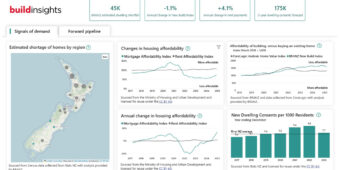REFORMULATING LOCKDOWN STATS
28 Oct 2020, Industry News, News

As a result of delays caused by Covid-19 on site work and in processing consent applications, Stats NZ has had to think carefully, and in some cases adapt the methods it uses, so that it still produces the most accurate and useful information possible
Data from Stats NZ provides valuable information on how every sector of the economy is performing, including building and construction.
Under Construction publishes – in print and online – the monthly reports produced by Stats NZ on the number of consents issued by building consent authorities around the country. This is important information, because it indicates the level of building work that homeowners intend to undertake.
Understanding whether consents are up or down from the month or year before can help confirm what builders might already know from their own pipeline of work, or from talking to others in the industry. Or it might be new information for some builders.
Government may also use this data to inform policy decisions. Plus, consents data feeds into economic analysis that seeks to assess the health of the country’s economy overall, which can affect the sentiment of the country and ultimately affect whether some clients go ahead with their planned work. So it’s fair to say these stats are pretty important!
The disruptions caused by the Covid-19 lockdowns meant that some of the regular methods that Stats NZ relies on to produce its data were no longer consistent – and were potentially misleading.
For example, a low level of consenting in one region would usually indicate fewer consents had been applied for. But during lockdown, it might instead show that council staff weren’t in the office and weren’t processing consents, or were processing them at a lower rate. On the other hand, a higher number of consents during lockdown in a particular region might be because more consents were applied for, or that council inspectors couldn’t visit sites, so instead were processing consents and therefore were able to consent more. In reality, both of these possibilities occurred during lockdown in different regions.
Then there’s ‘work put in place’ (WPIP), which is a measurement of actual building work, rather than consents. Except, crucially, Stats NZ uses the consent data as the key source for the WPIP data – because it is calculated that a certain percentage of consents will become builds actually taking place, and there is a calculated relationship between value when consented and value when built. This means that when the consents data is compromised or confused by events such as the lockdowns, the WPIP data would also be compromised – unless changes were made to how it is calculated.
So, it’s tricky to get the right info. How then does Stats NZ get the information it needs to produce the most accurate and useful data it can?
Building Activity Statistics – a revised model due
Building activity statistics estimate the value and volume of work put in place on building projects in New Zealand. The estimates include a modelled component, which is the part based on consenting data, and a surveyed component, where Stats NZ receives written responses from building companies and project managers/owners. Low-to-medium value builds have traditionally been modelled, while high-value builds have been surveyed. But Covid-19 lockdowns necessitated a change to this approach.
“Due to the impact of Covid-19, we have modified our methods to achieve as-accurate-as-possible data in spite of the disruption and data-difficulty caused by Covid-19 and the lockdowns,” acting building statistics manager Dave Adair explained.
Modelled building projects (low to medium value)
Pre-Covid-19, building projects were modelled if they had an estimated value below $1.22 million (for residential buildings) or $1.9 million (for non-residential buildings). By value, about three-quarters of residential and one-quarter of non-residential building activity is usually modelled. The model is based on a historical relationship between the estimated value of building consents and the value of work put in place over time.
However, because New Zealand was at Alert Level 4 at the beginning of the June 2020 quarter, then moved to Alert Level 3 on 27 April, construction work did not go ahead during this time, and the model would therefore be inaccurate if used unmodified.
To account for this, Stats NZ reduced the modelled component of building work put in place for the June 2020 quarter by 16 working days (approximately 26.2%). The March 2020 quarter modelled component of building work put in place was reduced by a similar working day factor – in that case, five working days (approximately 8.2%).
New experimental model
Building projects have clearly been affected by Covid-19 and the subsequent levels of lockdown, so Stats NZ is surveying an additional sample of medium-value building projects, which will contribute to a new experimental model designed to account for the effects of Covid-19.
This will help analyse building projects as a result of the lockdown levels in the March and June quarters, as well as the Level 3 lockdown in Auckland, and may result in revisions to the March and June quarters and subsequent periods.
Surveyed building projects (high value)
Residential projects are surveyed if they have an estimated building consent value of at least $1.22 million. Non-residential projects are surveyed if they have an estimated value of at least $1.9 million.
Stats NZ achieved a normal response rate in the June 2020 quarter so will not need to make changes to this component of the method.
Not black and white
Overall, the provision of accurate data that represents what activity is taking place in the building industry is not as simple as it might first appear. As Mr Adair concludes:
“Our work in estimating building work put in place is not black and white. We work with qualitative data and we have to carefully consider which information sources might help us and how we should best use that information. That way, we can make the statistics and insight as accurate as possible and as helpful as possible for builders and others who use it to help understand what has been happening and what may happen in the future.”
Register to earn LBP Points Sign in



